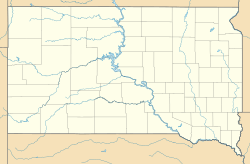Tigerville, South Dakota facts for kids
Quick facts for kids
Tigerville, South Dakota
Tiger City
|
|
|---|---|
| Country | United States of America |
| State | South Dakota |
| County | Pennington |
| Founded | 1878 |
| Abandoned | 1885 |
| Named for | Bengal Tiger Mine or the Lucky Tiger mining claims |
| Elevation | 5,485 ft (1,672 m) |
| Population
(2013)
|
|
| • Total | 0 |
| Time zone | UTC-7 (MST) |
| • Summer (DST) | UTC-6 (MDT) |
Tigerville, also known as Tiger City, was a small town in the Black Hills of Pennington County, South Dakota. It existed for a short time, from 1878 to 1885. Tigerville is now a ghost town, which means it's a place where everyone has left. It's a good example of how some towns grew quickly and then disappeared, especially during the gold rush.
Contents
How Tigerville Got Its Name
The name 'Tigerville' might have come from a mine called the Bengal Tiger Mine. This mine was located a few miles away. Another idea is that the town was named after some mining areas called the Lucky Tiger claims. Even though these claims don't appear on old maps, people who lived there said they were very close to the town.
A Brief History of Tigerville
The Town's Beginning
Tigerville was started in 1878. It was built in an area known as the King Solomon Mine. This place was famous for its rich deposits of gold and quartz. At its busiest, Tigerville had a post office, two stores, three saloons, a blacksmith shop, and a school. It also had a special barn for horses and carriages, which was a stop on an important travel route connecting Cheyenne, Custer, and Deadwood.
Growth and Decline
There was a mine nearby called the Bengal Tiger Mine. People thought it had a lot of valuable minerals, but it was never successfully mined. By 1880, Tigerville had about 200 residents. The town was important enough to send six representatives to a big political meeting for the Republican Party in South Dakota. This was a big deal because even Rapid City, South Dakota, a larger town, only sent ten representatives at that time. Tigerville eventually grew to have about 500 citizens.
However, like many mining towns, Tigerville's good times didn't last. When the mines closed in 1885, the town quickly lost its purpose. Many miners moved to other towns or started new lives on nearby ranches. By 1974, almost nothing was left of Tigerville. Only one house and the old sawmill remained.
Where Tigerville Was Located
Tigerville was situated in the Black Hills in the western part of Pennington County. The old town site is about 4.5 miles northwest of Hill City. You could find it where roads leading to Hill City, Deerfield Lake, and Rochford all met.


